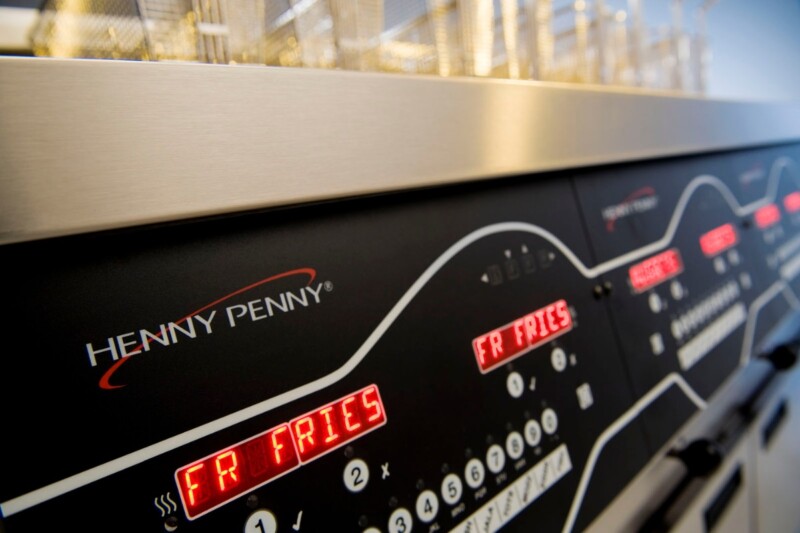SPONSORED CONTENT

What You Need to Know About Commercial Pressure Fryers
If you know anything about cooking deep fried chicken in a commercial kitchen, you probably know the difference between open frying and pressure frying. Open frying for crispy, crunchy breaded texture and slightly dryer inside; pressure frying for softer Southern-fried texture and a tender, juicy inside. You may even know that pressure fryers cook faster at lower oil temperatures, even if you’re not quite sure how. But did you know not every commercial pressure fryer works quite the same way?
It pays to understand enough about those differences to know that you are getting the full benefit of pressure frying and not something in between.
Be sure you’re getting 12 psi
Your pressure fryer must be able to achieve and maintain the ideal pressure of 12 psi (pounds per square inch) during the cook cycle. Much less than that, and you’re wasting your time. More, and such a fryer would be overbuilt for the purpose. That’s where the very important but scientifically boring dead weight valve comes in. It’s a weighted valve that stays shut as pressure builds to 12 psi and opens to release pressure in excess of that. If you’re looking at other pressure fryers, be sure to ask the manufacturer if they use a 12 psi dead weight – not all of them do.
Shape matters
One sure way to identify a Henny Penny pressure fryer is by its unique rectangular fry pot. Most other pressure fryers use a round or cylindrical design.
The initial boiling effect comes from rapidly expanding moisture on the surface of the food as it is vaporized by the extreme difference in temperatures. That energy is quickly dissipated in the form of steam and turbulence. The more widespread the turbulence, the more evenly heat is distributed throughout the volume of oil. That’s where corners come in. In a round vat, turbulence is reduced as oil flows along the curved vat wall, leaving a cold zone in the center.
By contrast, the flat walls and corners of a rectangular vat immediately disrupt this flow, causing chaotic or turbulent conditions everywhere in the vat. Cold spots cannot exist in a rectangular fry vat during cooking, whether there is a lid on it or not. Even at 12 psi, pressure fryers with round vats typically cook at higher temperatures to eliminate cold spots or layers as they form.
Long live your oil
Most of the time, switching to pressure frying can double the life of cooking oil. How? Pressurized cooking dramatically reduces oxidation, or “spoiling,” from the surrounding air that flows into an open vat of turbulent oil. Being able to cook at lower temperatures also puts less stress on your oil. But nothing extends the sweet spot of frying oil quite like filtering every chance you get. And that’s not going to happen if the only time you can afford to filter is when you drag out the portable unit at closing time.
Built-in oil filtration systems are standard on Henny Penny pressure fryers. In fact, the high-volume Velocity pressure fryer is designed to filter automatically after every cook cycle in about the same time it takes to rack the next load.
Ergonomics = efficiency
Nothing is more important than catering to the human element in a fast-paced commercial kitchen. The original color-coded spindle lid lock (since copied) made Henny Penny standard pressure fryers uniquely easy to use.
For the large capacity Velocity, we designed a smooth-working counterweighted lid lift that even a tiny person can easily raise, lower and lock into place with one hand. The uncluttered deck is set lower, too, so that same person can easily load racks into the basket at a comfortable height. The half racks (easy to handle) are sized to fit two to a sheet pan for loading directly into a holding cabinet or display warmer without the food ever being touched after cooking.
Two final big things
First, every new Henny Penny fryer is tested at the factory for operational integrity before shipping – this is a big reason they are so reliable. Second, Henny Penny designs and manufactures control boards in-house. No other fryer company does this. And that’s a big reason why Henny Penny fryers are so available (our distributors even keep fryers in stock)!
We were the first in the commercial pressure frying business 65 years ago. The reason we’re still trusted by the most successful restaurant brands? We never stopped engineering our fryers to balance oil savings, performance, and cost.
Ready to know more?
Henny Penny’s authorized distributors are pressure frying experts and are always happy to answer any specific questions. Schedule a commitment-free, educational product demo today and find out if pressure frying is right for your foodservice operation.
RELATED CONTENT
- Advertisement -
- Advertisement -
- Advertisement -
- Advertisement -
TRENDING NOW
- Advertisement -
- Advertisement -


